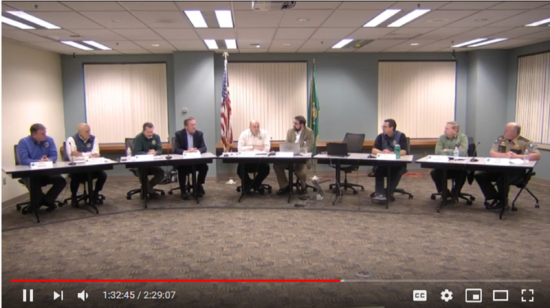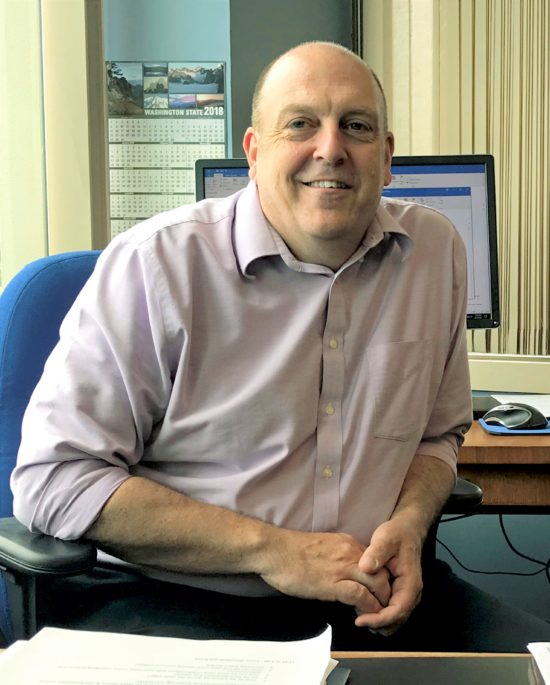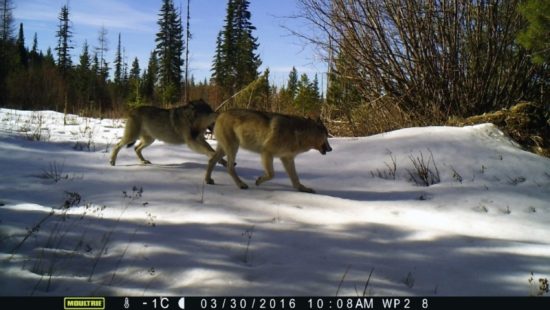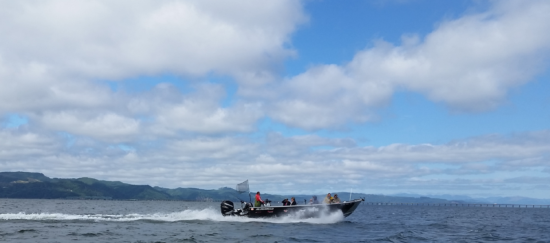
WDFW Shortfall Grows; Leaders Take Questions During Livestream
Washington fish and wildlife managers are now projecting they will have a $20 million budget shortfall over the coming two years — and it could more than double in the following two.
WDFW Director Kelly Susewind broke the news earlier this week during a 2.5-hour-long livestreamed virtual open house.

“We ended up with less than we needed to get through the biennium, which means we’re not going to be able to provide the services we had hoped to,” he said about the recently concluded legislative session.
Lawmakers did give WDFW a one-time $24 million General Fund bump to fill a preexisting $31 million hole instead of raising fishing and hunting license fees and extending the Columbia River salmon and steelhead endorsement.
But Susewind said that the shortfall also grew from that new initial $7 million difference to $20 million after legislators also “passed a lot of provisions that further increased our costs. Those increased costs came without additional revenue.”

This afternoon his budget and policy director Nate Pamplin said the $13 million ballooning was due to increased salaries for staffers and “other central service costs” that weren’t matched with new revenues; lower than expected disbursements from both the Pittman-Robertson and Dingell-Johnson Acts; and one-time hits from things like the Skagit catch-and-release wild steelhead fishery and Fish Washington app that would have been funded through the fee bill but now must be another way or get cut.
“We’re still reviewing what has been identified as at risk and trying to balance the budget,” Pamplin said.
Back on Monday’s live stream, Susewind acknowledged that legislators had “front loaded” the agency’s General Fund contribution towards the first year of the two-year budget “to come as close as we can to staying whole” in anticipation of working on it again when state senators and representatives return to Olympia next January .
But he also projected that the shortfall could grow to $46 million during the 2021-23 biennium if nothing’s done.
SUSEWIND HAS BEEN MAKING MORE USE of new ways to talk to WDFW’s constituents than past directors, and in this latest virtual town meeting he brought in a bevy of department heads and managers to talk about their programs and expertises.
But it also included about an hour’s worth of questions sent in by the public as they watched, and as you can imagine many inquiries dealt with the hot-button topics of the day — wolves, North of Falcon, Columbia fisheries.
One of the first questions was from a gentleman by the name of Bill who felt that over the past three years there’s been a lot of lost fishing opportunity and he wanted to know how WDFW was supporting sport anglers.
“We’re trying to maximize the opportunities within the constraints we have,” Susewind stated.
Those restrictions include all the Endangered Species Act listings on fish stocks that often swim alongside healthier ones, fisheries that require extensive and not-cheap monitoring for the state to receive federal permits to hold them.

Susewind said the agency was looking at ways to increase hatchery production, and he pointed to spill down the Columbia system to aid outmigrating smolts as well as habitat work to increase wild returns which would mean higher allowable impact rates on listed stocks
“This is an area I want to be direct with folks,” Susewind said. “I know there’s a ton of frustration around lack of opportunity at the same time we asked for an increase. I’d just ask folks to think through the situation. In these times of incredible constraints, declining runs, it costs more to actually provide the opportunity. The declining opportunity, the effort it takes to provide what opportunity is available is more.
“You all can make your own choice whether it’s a good investment if fees are worth it or not, but those fees are what are going to allow us to continue to manage, to allow us to hopefully turn around this run return and allow us to provide more opportunities,” he said, adding, “That’s what we’re trying to do. Time will tell if we’re successful.”
Asked whether WDFW was considering any early retirements to reduce the budget hole, Susewind said he couldn’t do that without a change in state law, but that staff cuts and not filling vacancies were being looked at.
A woman named Carol asked about a “conservation license,” and Susewind expressed some interest in it as a funding source though also for more durable, across the board funding. Pamplin added that the Reclaiming America’s Wildlife Act now in Congress was a “potential game changer … for us to invest in areas that need support.”
WDFW’s twin mandate tears it between providing harvest opportunities which raise money to pour back into providing more while also having to protect imperiled species that suck money the other way.

THIS AND RECENT YEARS HAVE SEEN A LOT OF ANGER about the results from North of Falcon salmon-season-setting negotiations and the pruning of opportunities in inland saltwaters, and during the livestream, a question from Chad asked why there couldn’t be open meetings between WDFW and all Western Washington tribes.
Susewind, who just emerged from his first iteration of the annual set-to, called the idea unwieldy and said that the agency had a responsibility to represent its stakeholders during the talks but that that didn’t allow for them to behind those closed doors.
Salmon policy lead Kyle Adicks was more blunt.
“The tribes are sovereign governments. They don’t have to meet with us if they don’t want to. They don’t have to meet with members of our public if they don’t want to,” he said. “Ultimately it’s the tribes’ decision: If they want to have a government-to-government meeting, then that’s what we have.”

WDFW piggybacks on the tribes’ federal nexus to get sport salmon seasons approved faster than they otherwise might be.
While Adicks also pointed back to a January 2017 Fish and Wildlife Commission briefing on the Open Public Meetings and Administrative Procedures Acts, in recent days a long-threatened legal challenge has been filed that contends that how WDFW sets salmon seasons with the tribes violates those two state laws.
Filed by Twin Harbors Fish and Wildlife Advocacy of McCleary, the petition asks a Thurston County Superior Court judge to throw out the state’s adopted 2019-20 salmon seasons.
WDFW had no comment when I asked about the matter earlier this week — “As you probably know, we don’t comment on ongoing litigation” — but did pass along their efforts to increase transparency:
WDFW values and works hard to provide transparency in the development of fishing seasons. The development of fishing seasons also includes work with tribal co-managers, and those meetings involve highly sensitive government-to-government negotiations with 20 individual treaty tribes during the North of Falcon process.
In 2019, the department held more than a dozen public meetings to discuss potential salmon seasons in various locations around the state. Three of the meetings were live-streamed on WDFW’s website and made available for the public to watch later. WDFW also provided the public with the option to submit comments electronically through the department’s website. During the closing portion of North of Falcon negotiations, which took place during the Pacific Fishery Management Council meeting in California, the department had daily conference calls with advisors and constituents to discuss the latest developments.
ANOTHER QUESTION FOCUSED ON WHY the Fish and Wildlife Commission had allowed gillnets back into the Columbia this year, gear that had been schedule to be phased out by 2017 under fishery reforms.
Susewind called that policy an adaptive one that aimed to keep commercial fisheries viable on the big river too but that replacement gear hasn’t been figured out, so the citizen panel decided to extend gillnetting “while we figure out how to implement the rest of the policy.”
With spring Chinook now coming in far below forecast and summer Chinook not even opening, gillnetting this year will be limited to a handful of days targeting fall Chinook near Vancouver at the end of summer.

Dozens more questions were asked and they covered the gamut:
* What WDFW was doing to increase branch-antler bull elk opportunities;
* How much it costs to investigate wolf depredations;
* Whether WDFW plans to dispute the status of perennially fishery constraining mid-Hood Canal Chinook as a distinct stock (they’re essentially locally adapted Green/Duwamish strays released into the Skokomish);
* Reducing commercial bycatch;
* If WDFW was considering opening a spring bear general season;
- What the agency was doing to increase access to salmon and steelhead, boosting mule deer and elk populations, and upping steelhead production;
* If WDFW can fine people who create repeat predator issues;
- If Westside- and Eastside-only deer tags were possible;
* Instead of bag limits, if tags for salmon were possible;
* The latest on Southwest Washington hoof rot.
* And why weren’t WDFW staffers required to be hunters and anglers.
To see WDFW’s responses, skip to about the 1:23:00-mark of the digital open house.

“I hope we have your continued support as we try to turn this around and provide more opportunity in this state for hunting and fishing,” Susewind said in wrapping it up.
As he stated earlier, time will tell if WDFW is successful.
